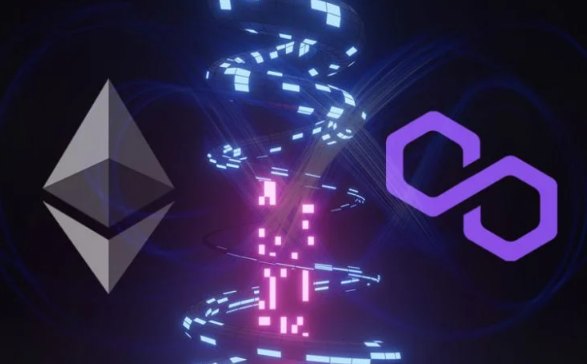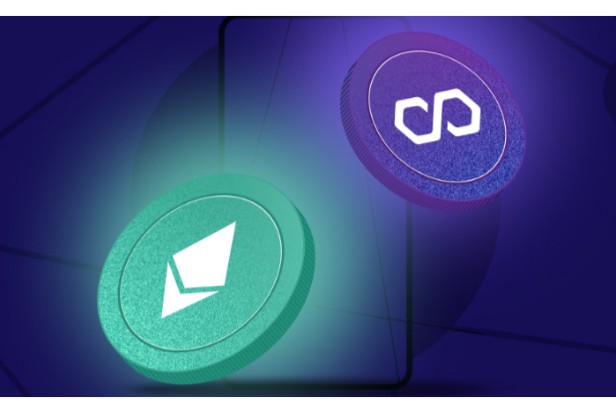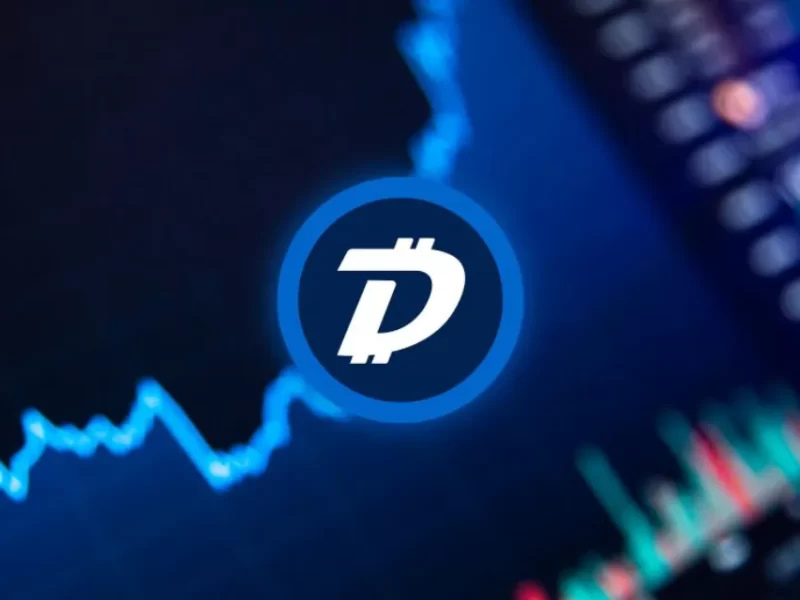Polygon is a “Layer-2” scaling solution for Ethereum, a way to take advantage of Ethereum’s advantages without paying the infamous gas fees that harm its users.
What is Ethereum?
The cryptocurrency Ether (ETH) and thousands of decentralized applications are powered by Ethereum, a blockchain-based technology that is community-run. For the verification of application code, also known as smart contracts, it can create a secure network. Transactions on Ethereum are secure, verifiable, and give full ownership of them as well as visibility into them. For transactions, an Ethereum account must be created, and the native currency of Ethereum, ether, is used for payment.
Read More: Crypto Compare Guide 2023 – Exchanges, Wallets, Tokens & More
Advantages:
- For trading or buying NFT, Ethereum offers the highest level of security. The Ethereum blockchain uses gas fees to approve transactions, giving users access to a secure network.
- In the blockchain and NFT markets, Ethereum is becoming more well-known.
- Ethereum supports auctions, which can be useful for a seller as they can sell their NFT collection to the highest bidder and also set a minimum amount for an NFT.
Disadvantages:
- For approving a transaction, Ethereum levies high gas fees. The cost of gas varies from $50 to $200.
- Transactions on Ethereum move slowly.
What is Polygon?
Blockchain technology called Polygon, which is based on Ethereum, offers platforms with increased scalability. It is a layer 2 aggregator with the goal of building an Ethereum ecosystem with multiple chains. Polygon uses the security of Ethereum. The polygon’s main goal is to increase the use of Defi (Decentralized Finance) tools and applications. Currently, the Polygon network is hosting about 3000 decentralized applications, and more than 80 well-known companies have switched from the Ethereum main chain to the Polygon network. Since EVM (Ethereum virtual machine) blockchain-like polygons are very similar to Ethereum, developers are compelled to migrate from Ethereum to these polygons in order to expand their user base and expand their reach.
Read More: Solana Vs. Polygon – What’s the Difference & How to Choose
Advantages:
- On its blockchain network, Polygon doesn’t charge gas fees. Although there are no gas fees when using Polygon to sell or buy NFT, there are very small gas fees when converting Ethereum ETH to Polygon ETH.
- The platform Polygon is very scalable.
- For more transactions, Polygon is built on the Ethereum blockchain.
Disadvantages:
- When it comes to security, Polygon is less protected.
- The NFT market is less well-known to Polygon.
- The platform of Polygon Blockchain does not support an auction facility.
NFT
The creation of non-fungible tokens results in the creation of a distinctive digital signature for digital assets; this signature identifies the ownership of your possessions, which can be purchased and sold for real money or any other asset, such as NFT. Every NFT represents a distinct resource owned by a specific person and is not interchangeable. Each NFT contains distinguishable information that makes it verifiable and clearly defined, such as the owner of the digital resource and the parties who purchased it. NFTs offer the best security for one’s resources and assets because they are impossible to copy or forge, just like digital certificates are impossible to forge.
How Do Polygon and Ethereum Differ?
Popular blockchain initiatives include Polygon and Ethereum. While Ethereum is an open-source, public blockchain platform that supports smart contracts and decentralized applications (dApps), Polygon is a scaling solution for the Ethereum network.
Many of Ethereum’s scalability issues are being addressed by Polygon. To boost transaction throughput and cut costs, it makes use of second-layer techniques like Plasma, Optimistic Rollups, and zkRollups. With Polygon, developers can deploy their dApps on the network without having to change their code because it is built to be compatible with Ethereum.
Providing a platform for decentralized applications (dApps) is the main goal of Ethereum, in contrast. On its blockchain, it enables developers to create, distribute, and execute smart contracts. Along with decentralized exchanges, lending protocols, and stablecoins, Ethereum also supports the creation of digital assets (tokens).
In the end, Polygon is intended to be a layer that the Ethereum network can build upon, with Ethereum itself concentrating on offering an open platform for developers to create dApps. Together, these two projects—each significant in their own right—offer a potent synergy of scalability, security, and interoperability.
Blockchain Transaction Fees
The transaction fees between Polygon and Ethereum are one of the main distinctions. Layer 2 network Polygon sits on top of Ethereum and uses Ethereum’s security. Due to its extremely low transaction fees, Polygon ultimately becomes a slightly less “secure” network.
| Token Transfer | $2.10 | $0.00065 |
| NFT Transfer | $6 | $0.00055 |
| WETH to ERC20 Swap | $14 | $0.0012 |
| Add/Remove Liquidity | $15 | $0.0017 |
| OpenSea Swap | $40 | $0.003 |
Polygon Vs Ethereum: NFTs
Both Polygon NFTs and Ethereum NFTs are now supported by the OpenSea platform. Polygon NFTs were added because regular investors needed a substitute because it was becoming too expensive for them to swap on Ethereum.
Although Polygon is less expensive, the NFTs on their network are significantly worse and have little cultural significance. Azuki’s, Cryptopunks, Bored Ape Yacht Club, and Pudgy Penguins are just a few of the most well-known NFTS that are only available on Ethereum and not on other secondary chains like Polygon.
Polygon Vs Ethereum: DeFi
Since it costs too much to deposit and withdraw coins or liquidity, using DeFi products on Ethereum is inefficient if you manage less than $1 million in capital. Your yields on Ethereum are ultimately significantly decreased by the gas fees, rendering your yield farming on the network unnecessary.
For instance, using the AAVE platform on Polygon rather than Ethereum will allow you to achieve the same yield while paying much lower transaction costs. For smaller accounts, Polygon is unquestionably the best platform through which to communicate with DeFi.
Polygon Vs Ethereum: GameFi
The gaming industry has completely moved away from the ETH blockchain due to how expensive it is to transact on it. Due to the Polygon blockchain’s low fees and quick finality, well-known GameFi games like CryptoRaiders and CryptoUnicorns have moved natively to it.
This ultimately means that Polygon is your best option once more if you’re looking to play blockchain games.
How Does Polygon Improve Ethereum’s User Experience?
With a few extra features, Polygon offers a nearly identical user experience to Ethereum. After adding Polygon, users can interact with it via the well-known Metamask Web3 browser wallet and import their existing Ethereum address (but not their Ethereum assets) into Polygon. Users must purchase MATIC and withdraw it to their Polygon wallet before they can interact with Polygon dApps. MATIC can be bought on a cryptocurrency exchange like Coinbase or through ‘on-ramp’ services. Gas fees on Polygon are paid in MATIC tokens rather than Ethereum’s ETH (also known as ‘ether’). Users can access services like the Polygon/Ethereum Bridge, third-party on-ramp services, on-chain token swapping, and MATIC staking to earn interest by taking part in running the Polygon blockchain by logging in to the Polygon Wallet using their Metamask wallet.
The Polygon Bridge must be used to transfer assets between Ethereum and Polygon. Despite having the same address, tokens and NFTs in an Ethereum wallet won’t show up in a Polygon wallet and vice versa. This is due to the fact that a blockchain bridge is necessary to transfer assets between Polygon and Ethereum because they are both distinct blockchain networks. It can take between 22 and 30 minutes to transfer assets from Ethereum to Polygon, and doing so will cost you several dollars in ETH in Ethereum gas fees. Transferring back to Ethereum from Polygon requires three transactions—one in MATIC and two in ETH—and can take up to three hours to complete.
Polygon is rightfully regarded as Ethereum’s best scaling solution due to its numerous high-profile partnerships, transaction fees in the cents, the abundance of practical services built into its native wallet, the ambitious developer team pushing the boundaries of Web3 and blockchain technology, and the potential to process more TPS than the Visa global payments network. Although the most recent Ethereum upgrade decreased carbon emissions, it had no impact on gas costs or TPS. Polygon will always be helpful for increasing even after these problems are fixed, Ethereum’s capabilities will increase.

Ethereum Vs Polygon: Which One Will Rule DApps Development?
With each of the two having advantages and disadvantages, both platforms are well-liked options for the creation of decentralized applications. Before reading on to find a detailed comparison based on numerous factors, take a look at the infographic below that compares Polygon and Ethereum to quickly understand the key differences between the two.
Architecture
The state of the blockchain network is defined by its architecture. So, when selecting a platform, it is one of the most important factors to take into account.
Ethereum leverages a stateful architecture, meaning that all the transactions on the platform are recorded in the state. The entire network must update the copy to reflect the most recent transaction whenever a new transaction takes place.
Consider sending 10 ETH to a recipient via the Ethereum network. The network of miners must update the records to reflect the architecture in order to complete the transaction, which is why it takes much longer than in stateless networks.
In contrast, Polygon promotes a borderless economy and works like a PoS blockchain where exchanges are displayed as clusters. Matic, the currency of Polygon, is additionally employed for transactions.
Polygon has a four-layered architecture:
- The Ethereum layer, which is the staking, transaction finality, and other related conditions are settled by an Ethereum-based smart contract. between Ethereum and Polygon
- The security layer, which provides a periodical check of the validity of any Polygon chain for a fee and offers additional security to the chains
- The Polygon network layer, represented as the ecosystem of networks that are responsible for handling local consensus and building their blocks
- The execution layer, which implements the platform’s EVM, executing smart contracts
Consensus Algorithm
The consensus algorithms used by Polygon and Ethereum differ significantly from one another. Ethereum is currently based on the PoW consensus, which requires high processing power and is the main reason for The pricey and sluggish transactions on Ethereum. A platform’s performance is affected by its processing power, but it also provides better security.
Ethereum is currently transitioning to PoS, which will enable it to address the platform’s issues.
Polygon uses the PoS consensus, which ensures better performance compared to The blockchains that are launched on Polygon are PoW and have a PoS security layer.
Additionally, Polygon depends on a variety of technologies to enable the platform to guarantee high scalability and low gas costs. Optimistic rollups, ZK-rollups, and plasma chains fall under this category.
Polygon applies a layer-two scaling technology named Plasma, which is one of the factors behind mass adoption of Polygon. For the asset flow between the root and child chains to be possible, this technology depends on bridges. While reducing the transaction load on the primary blockchain to enable quicker and more affordable transactions, Polygon Plasma chains provide a framework for the creation of decentralized applications.
ZK-rollups and optimistic rollups, the other scaling solutions used by Let the platform validate transactions almost instantly, Polygon.
Platform Ecosystem and Key Projects
With a number of well-known DeFi projects, such as Uniswap, Compound, Oasis, and Aave, Ethereum currently has one of the largest ecosystems.
For NFT-based projects like OpenSea, Rarible, and Audius, Ethereum is one of the top platforms. It is a top choice for metaverse development, with Decentraland and Cryptovoxels being the most well-known projects, and for game development, with Axie Infinity and Dark Forest serving as the best project examples.
According to the quantity of dApps developed on each platform, Polygon (about 19,000) performs significantly better than Ethereum (about 3,000) in the Ethereum-Polygon competition. The top DeFi apps on Polygon are Curve Finance, SuchiSwap, QuickSwap, Sorbet Finance, and AAVE. Numerous DAOs, including Blockonomist, El Dorado, BlobDAO, and Idavoll network, are also based there.
Additionally, Polygon can point to some intriguing collaborations. In order to create a rare NFT with a yield of up to 50%, for instance, it collaborated with a GOGOcoin dApp. In order to enable users to stake Matic in a safe and decentralized manner, Lido Finance also announced a partnership with Polygon.
Level of Decentralization
As you may already be aware, all information is stored in nodes or validators, which are dispersed across the globe, in a decentralized blockchain. Almost all blockchain platforms today make the decentralized claim. But how can we accurately measure this? Using the Nakamoto Coefficient is one option.
The Nakamoto Coefficient is a measurement of the number of validators required to cooperate in order to prevent any given blockchain from operating efficiently. The decentralization of a blockchain will actually increase with the number of nodes it has.
The Nakamoto Coefficient for Polygon indicates that it has 100 validators and a coefficient of 2. Because of the size of its network and the lack of data for Ethereum, the Nakamoto Coefficient explains that it is impossible to know how many validators there are in total.
Buterin, the creator of Ethereum, measured this indicator in 2020 and came up with a coefficient that ranged between 25 and 35. The estimation was based on Ethereum’s 7,400 nodes at the time. As a result, Ethereum would unquestionably receive a win in our Polygon vs. Ethereum comparison if we were to award points.
Scalability and Transaction Fees
It is advisable to pay attention to the scalability factor when selecting the platform for your dApps projects because it is this that determines whether the network is scalable enough to complete the transaction.
Consider Ethereum, which currently processes between 13 and 15 TPS, a lower rate than the majority of its rivals. The good news is that Ethereum 2.0 claims to be able to handle 100K TPS; all that is left to do is wait and see if it will keep its word. Better scalability and transaction speed are guaranteed thanks to Polygon’s 65,000 TPS processing capacity.
When comparing Polygon gas fees to Ethereum gas fees, the indicator is quite unstable and subject to large swings. On Ethereum, the average transaction fee is currently over $6, but depending on network congestion, it may be as high as tens or even hundreds of dollars. Transaction fees from Polygon are significantly more enticing at $0.01 or less.
Market Cap and Latest Developments
Currently, Polygon has a market cap of 4,955 million, whereas Ethereum is estimated to have a market cap of 223,597 million. However, we must keep in mind that Polygon is a more recent network than Ethereum.
A group of libraries known as Ethereum-cryptography 1.0 were just released by Ethereum. These libraries seek to establish a faster, more secure cryptography stack for Ethereum and to support various project types in the area.
In order to foster the growth of its community, Polygon is currently rewarding frequent web3 hackathons. Additionally, it is attempting to build NFTs into its platforms. Recently, as a result of this, it formed a partnership with Adidas and Prada to create their first joint NFT project on this platform.
Should We Use Ethereum Or Polygon on OpenSea?
NFT is created on a blockchain, with Ethereum being the most frequently used network.
- Any transaction involving the purchase or creation of NFT on the Ethereum blockchain must be approved before it can proceed.
- Energy is needed for a transaction to be approved, and on the Ethereum blockchain, you are compensated for this energy through a system called Gas.
- Demand affects how much gas costs vary, so higher demand results in higher costs.
- Transactions made on the Ethereum blockchain typically take a long time and are expensive because there is currently no way to recover from congestion and a high volume of transactions being submitted at once.
It almost seems like an addition to the Ethereum blockchain, but Polygon does not charge gas fees.
- We have the main Ethereum blockchain and side chain polygon, and there are two separate chains, but there is something called a bridge which ties them together. Polygon uses side chains so instead of expanding the capacity on the block of the original Ethereum blockchain polygon utilizes its own block to assist in allocating the load.
- By locking up the resources on one side while unlocking the other, the bridge converts assets or resources from one chain.
- On the polygon side chain, there is less congestion, and there is infrastructure in place to speed up and reduce the cost of the transaction.
Final Verdict
The best blockchain for high-net-worth investors to use the wide range of DeFi products to increase yield and farm new tokens is Ethereum. Even though there are fewer top-tier on-chain products and lower overall yields on the Polygon blockchain, we advise using it if you have a smaller account to take advantage of the lower fees.



